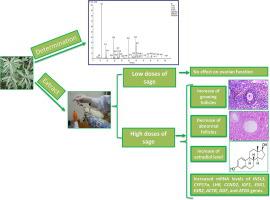Journal of King Saud University-Science ( IF 3.7 ) Pub Date : 2020-12-26 , DOI: 10.1016/j.jksus.2020.101319 Abdulkarem Alrezaki , Nouf Aldawood , Shamsa Alanazi , Maria Arafah , Zuzana Fabova , Yacine Badjah , Alexander V. Sirotkin , Saleh Alwasel , Abdel Halim Harrath

|
Objectives
Salvia officinalis (sage) is widely sold in Saudi Arabia to make a popular herbal tea that women with reproductive disorders can drink daily. Despite the wide use of sage in traditional medicine, to our knowledge, little attention has been given to its effect on female reproduction. Our purpose was to understand the effects of sage extract on ovarian function to potentially shed light on its use in treating female infertility.
Methods
Forty female Wistar virgin female rats were randomly assigned to four groups, with 10 animals in each group. The control group received distilled water, and the three treatment groups received different concentrations of sage extract: 3.5, 15 or 60 mg/kg during 14 days. Ovarian tissues were cut into 5-μm sections and stained with hematoxylin and eosin. Plasma levels of reproductive steroids were measured using ELISA, and gene expression was examined via RT-PCR.
Results
Our results showed that low doses of sage (3.5 mg/kg and 15 mg/kg) have no effects on serum concentration levels of steroid hormone, the number of growing follicles, and on the transcripts of the steroidogenesis and folliculogenesis genes. In contrast, a high dose of the extract (60 mg/kg) significantly increased estradiol concentration levels. As a result, the number of growing follicles increased, while the number of abnormal follicles significantly decreased. Interestingly, sage extract also affected mRNA levels of genes involved in folliculogenesis and steroidogenesis processes. Two autophagy related genes, LC3 and ATG12, were not affected, but all of the investigated genes, INSL3, CYP17a, LHR, CCND2, IGF1, ESR1, ESR2, ACTB, GDF, and ATG5, significantly increased with the highest dose of sage.
Conclusion
As a remedy, sage extract is best used at a high dose when treating female infertility disorders, as sage extract may promote ovarian function by stimulating folliculogenesis and steroidogenesis.
中文翻译:

食用鼠尾草(鼠尾草)可刺激雌二醇激素释放并控制卵泡生成,类固醇生成和自噬,从而促进卵巢功能
目标
鼠尾草(Salvia officinalis)(鼠尾草)在沙特阿拉伯广泛销售,是一种流行的凉茶,患有生殖系统疾病的妇女可以每天喝。尽管圣人在传统医学中得到了广泛使用,但据我们所知,很少有人注意它对女性生殖的影响。我们的目的是了解鼠尾草提取物对卵巢功能的影响,以潜在地阐明其在治疗女性不育症中的用途。
方法
将四十只Wistar雌性雌性大鼠随机分为四组,每组十只动物。对照组接受蒸馏水,三个治疗组在14天内接受不同浓度的鼠尾草提取物:3.5、15或60 mg / kg。将卵巢组织切成5-μm切片,并用苏木精和曙红染色。使用ELISA测量血浆中类固醇的水平,并通过RT-PCR检查基因表达。
结果
我们的结果表明,低剂量的鼠尾草(3.5 mg / kg和15 mg / kg)对甾体激素的血清浓度水平,生长的卵泡数目以及甾体生成和卵泡生成基因的转录本均无影响。相反,高剂量提取物(60 mg / kg)显着提高了雌二醇的浓度水平。结果,正在生长的卵泡数量增加了,而异常卵泡的数量却明显减少了。有趣的是,鼠尾草提取物还影响了参与卵泡形成和类固醇生成过程的基因的mRNA水平。两个自噬相关基因LC3和ATG12均未受影响,但所有研究的基因INSL3,CYP17a,LHR,CCND2,IGF1,ESR1,ESR2,ACTB,GDF和ATG5 最高剂量的鼠尾草显着增加。
结论
作为一种治疗方法,鼠尾草提取物在治疗女性不育症时最好以高剂量使用,因为鼠尾草提取物可以通过刺激卵泡生成和类固醇生成来促进卵巢功能。










































 京公网安备 11010802027423号
京公网安备 11010802027423号